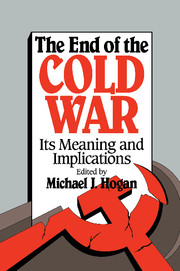Book contents
- Frontmatter
- Contents
- Preface
- The Authors
- Dedication
- 1 Introduction
- 2 An End to Which Cold War?
- 3 The Cold War, the Long Peace, and the Future
- 4 Quiet Cataclysm: Some Afterthoughts on World War III
- 5 Some Lessons from the Cold War
- 6 Nuclear Weapons and European Security during the Cold War
- 7 Victory in the Postwar Era: Despite the Cold War or Because of It?
- 8 The Wicked Witch of the West is Dead. Long Live the Wicked Witch of the East
- 9 The End and the Begining
- 10 A Balance Sheet: Lippmann, Kennan, and the Cold War
- 11 Why Did the Cold War Arise, and Why Did It End?
- 12 A View from Below
- 13 The End of the Cold War and the Middle East
- 14 The End of the Cold War in the Near East: What It Means for Historians and Policy Planners
- 15 After the Cold War: The United States, Germany, and European Security
- 16 The End of the Cold War: A Skeptical View
- 17 The End of the Cold War, the New Role for Europe, and the Decline of the United States
- 18 The Fading of the Cold War—and the Demystification of Twentieth-Century Issues
- 19 The U.S. Government, a Legacy of the Cold War
- 20 Foreign Policy, Partisan Politics, and the End of the Cold War
- 21 Beyond Bipolarity in Space and Time
- 22 A Usable Past for the Future
- Selective Bibliography
- Index
14 - The End of the Cold War in the Near East: What It Means for Historians and Policy Planners
Published online by Cambridge University Press: 18 December 2009
- Frontmatter
- Contents
- Preface
- The Authors
- Dedication
- 1 Introduction
- 2 An End to Which Cold War?
- 3 The Cold War, the Long Peace, and the Future
- 4 Quiet Cataclysm: Some Afterthoughts on World War III
- 5 Some Lessons from the Cold War
- 6 Nuclear Weapons and European Security during the Cold War
- 7 Victory in the Postwar Era: Despite the Cold War or Because of It?
- 8 The Wicked Witch of the West is Dead. Long Live the Wicked Witch of the East
- 9 The End and the Begining
- 10 A Balance Sheet: Lippmann, Kennan, and the Cold War
- 11 Why Did the Cold War Arise, and Why Did It End?
- 12 A View from Below
- 13 The End of the Cold War and the Middle East
- 14 The End of the Cold War in the Near East: What It Means for Historians and Policy Planners
- 15 After the Cold War: The United States, Germany, and European Security
- 16 The End of the Cold War: A Skeptical View
- 17 The End of the Cold War, the New Role for Europe, and the Decline of the United States
- 18 The Fading of the Cold War—and the Demystification of Twentieth-Century Issues
- 19 The U.S. Government, a Legacy of the Cold War
- 20 Foreign Policy, Partisan Politics, and the End of the Cold War
- 21 Beyond Bipolarity in Space and Time
- 22 A Usable Past for the Future
- Selective Bibliography
- Index
Summary
The primary concern of U.S. policy in the Near East during the Cold War was the potential Soviet threat to the sovereignty and territorial integrity of the Soviet Union's southern neighbors, and hence to Western interests in the region. Although the U.S. role in the post-World War II Near East was unprecedented, the geopolitical factors involved were not. Since the nineteenth century, a rivalry between the expanding Russian and British empires had been played out in an arena that stretched from the Balkans to British India. The competition for influence in the buffer states between their empires was subsumed under various geographical focuses: the “Balkan Problem,” the “Eastern Question,” the “Persian Problem,” and the “Great Game.” In these regions the Great Powers attempted to carve out their respective spheres of influence. In order to survive, meanwhile, the so-called buffer states allied among themselves against threats from without, played one power off against the other, or looked to third powers, such as Germany, for assistance. After World War II, survival of the buffer states was threatened by the relative disparity between Soviet and British power and by the Soviet Union's policies toward its southern neighbors. Because Germany had been crushed, Iran and Turkey turned to the United States for assistance, and the United States responded.
In subsequent years, the United States attempted to replace a decreasing British presence with a series of commitments—articulated in presidential pronouncements, or“doctrines”—to the re-gion's defense against threats, both real and perceived, from the Soviet Union.
- Type
- Chapter
- Information
- The End of the Cold WarIts Meaning and Implications, pp. 161 - 174Publisher: Cambridge University PressPrint publication year: 1992



